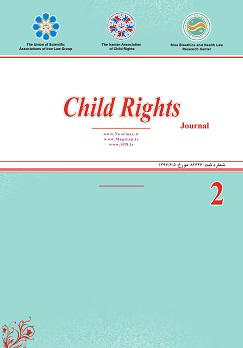رهیافتهای حقوقیِ حمایت از کودکان در برابر خشونت در محیطهای آموزشی
الموضوعات : حقوق کودکمحمدمهدی مقدادی 1 , محمدمهدی بادامی 2
1 - دانشیار دانشکده حقوق، دانشگاه مفید، قم، ایران
2 - کارشناس ارشد حقوق بشر از دانشگاه مفید، قم، ایران
الکلمات المفتاحية: کودکان, خشونت, حمایت, محیط آموزشی, حقوق بشر,
ملخص المقالة :
آموزش و پرورش به عنوان حقی اساسی از حقوق انسانی کودکان، نمایانگر توسعه جوامع انسانی و رشد و تعالی کودکان در جوامع امروزی میباشد. بیتردید محیطهای آموزشی در راستای تحقق چنین حقی باید از فضایی امن و مطلوبی جهت افزایش سلامت روانی کودکان در فراگیری دانش و تحقق تربیت و پرورش آنان برخوردار باشد. لیکن با وجود رویکردهای تربیتی و اصلاحمحور نسبت به رفتار کودکان و برقراری نظم و انضباط در فضای حاکم بر آموزش، پدیده خشونت در چنین محیطهایی به طور فزایندهای گسترش پیدا نموده است. از این رو در این پژوهش، با بررسی و تبیین خشونت علیه کودکان در محیطهای آموزشی بر اساس اسناد نظام بینالملل حقوق بشر و همچنین معیارهای نظام حقوقی ایران نسبت به حق کودکان و حمایت از آنان، راهکارهایی را در جهت مقابله و پیشگیری از بروز چنین پدیدهای در محیطهای آموزشی ارائه گردیده است.
1. Meghdadi MM. Protecting Children Against Violence, A Collection of Children's Rights Articles (A Comparative Study of Islam and International Documents). Qom: Mofid University Press; 2014.
2. National Committee on Violence. Instructions for Australia. Australia: National Violence Committee of the Canadian Institute of Criminology; 1990.
3. Asadi LS. Investigating the concept of a child with an approach to the criminal field. Calligraphy of Sadegh 2007; 24(45-46): 34-58.
4. Peyvandy GH-R. Child rights. Tehran: Organization for Research in Islamic Culture and Thought; 2011.
5. Ibn Babuyeh A. Ibn Babuyyah Fatawa Collection. Qom: No Name; No Date.
6. Council of Europe Special Rapporteur on Human Rights and Special Representative of the Secretary-General of the United Nations. Child Violence Case Report. New York: United Nations; 2011.
7. United Nations. Annual Report on Children's Rights Studies. New York: United Nations; 2006.
8. UNICEF. Children and violence. Inchonii Magazine 1997; 22(2): 1-22.
9. United Nations. Convention on the Rights of the Child Public Comment No.13. New York: United Nations; 1989.
10. Alhar al-Ameli M. Shia fixtures. Beirut: Al-Arabiya Darahiyah; 1416.
11. Karimi Jahromi A. Al-Dura'im al-Mudood in the decrees of al-Hudud. Qom: Holy Qur'an Publishers; 1414. Vol.2.
12. Al-Majlesi MB. Bihar. Tehran: Al-Maktabi al-Islamiyyah; No Date.
13. Alhely J. Al-Qadr al-Fitr in the description of al-Muqtasir. Qom: Seyyed al-Shohada Institute; 1364.
14. Gholami Tazeh Ghaleh T. Oneness. Physical punishment of children in jurisprudential teachings of domestic law and international documents. Jurisprudence and Islamic Law Research 2012; 39(12-13): 107-120.
15. United Nations. Committee on the Rights of the Child Public Comment No.8. New York: United Nations; 2008.
16. Khoshbakht F. Conceptual Model of Elements and Dimensions of Physical Punishment Based on Internal and External Studies. Journal of Humanities of Mofid University 2012; 1(13): 7-13.
17. Etienne J, Krug L, Sweetheart JA, Bay A. Zie and Raphael Lausanne. World Report on Violence and Health. Geneva: World Health Organization; 2002.
18. Hodgkin R, Newell P. Handbook of Implementation of the Convention on the Rights of the Child: United Nations Children's Fund. New York: UNICEF; 2007.
19. Iravaniyan A. Child abuse from cause to response. Tehran: Khorsandi Publications; 2009.
20. Imani M. Bullying at school and the role of parents and educators in dealing with it. Journal of Transplantation 2004; 296(1): 14-19.
21. Paulo Sergio P. World Report on Violence Against Children. Paris: UNICEF; 2006.
22. Bassami M. The Concept of Weapons in Jurisprudence and Criminal Law of Iran. Iranian Journal of Hearing 1394; 112(1): 56-63.
23. Mir Mohammad Sadeghi H. Crimes against public safety and security. Tehran: Publication Mizan; 2007.
24. Naseh Alvan A. Education of al-Awlad fi al-Islam. Beirut: Dar es Salaam; 1406.
25. Sheikh Tusi M. Al-Amamieh's jurisprudence. Tehran: Mortazavi Publications;1999.
26. Husseinkhah SJ. Punishing Children in the International System of Human Rights and the Jurisprudence of Imamieh. Qom: Jurisprudence Center of Imams (AS); 2008.
27. Ansari GH. Ta'zir from the perspective of jurisprudence and law. Qom: Institute of Islamic Sciences and Culture; 2006.
28. Elderbill A. Al-Fayedee Assembly of Valbaran. Qom: Al-Nusra al-Islam Institute; 1416.
29. Lankarani MF. Detailed al-Shariah Description of Tahrir al-Wasilah, the Book of Al-Hudud. Qom: Jurisprudence Center of Imams (AS); 1422.
30. Al-Maqrizi A. Amta-al-asma. Beirut: Dar al-Katib al-Umayyah; 1420.
31. UNESCO. New tools for effective school health. New York: No Name; 2004.
32. Grossman DC. The effectiveness of violence prevention curriculum in primary school children. Journal of the American Medical Association 1997; 277(20): 1605-1611.
33. United Nations Committee on the Rights of the Child Public Opinion No.15. Finland: United Nations; 2005.
34. Count A. A Survey of Space and Sexual Relations in a Durban High School. Project Magazine 2004; 54(1): 59-75.
35. Green M. Reduce violence and aggression in schools. Sage Magazine 2005; 6(3): 236-256.
36. Chigonta F. Project Evaluation Report for Children's Rights Clubs in Zambia, Lusaka, Sweden. Chicago: UNICEF; 2005.
37. Folkman Salazar C. Violence against children. Journal of Human Rights of Mofid University 2007; 4(2): 27-34.
38. Corey C. International Report on Child Health Behaviors in School 2001 and 2002. Europe: World Health Organization; 2004.


